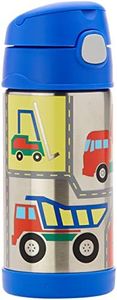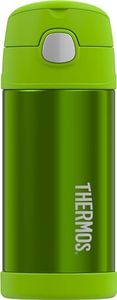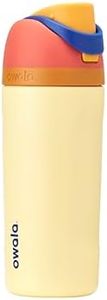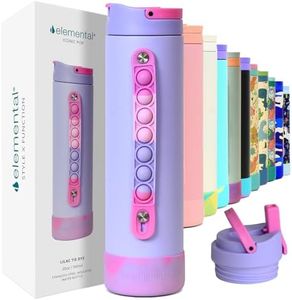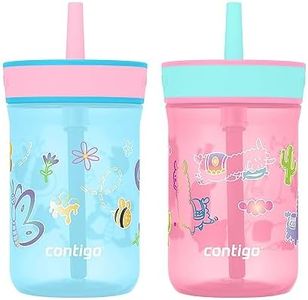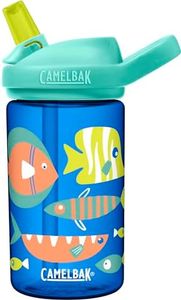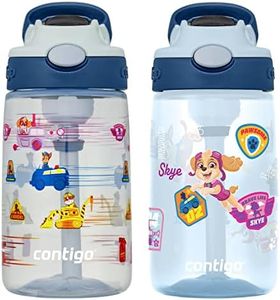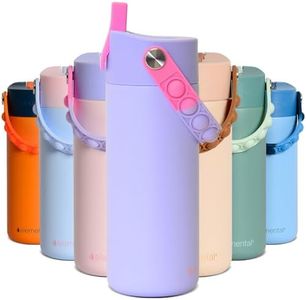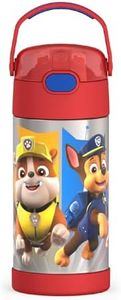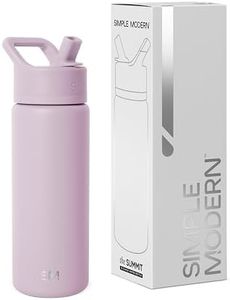We Use CookiesWe use cookies to enhance the security, performance,
functionality and for analytical and promotional activities. By continuing to browse this site you
are agreeing to our privacy policy
10 Best Kids Water Bottles
From leading brands and best sellers available on the web.Buying Guide for the Best Kids Water Bottles
Choosing the right water bottle for kids involves balancing comfort, safety, and practicality. Since children will use these bottles daily at school, sports, or outings, picking one that fits their needs and habits is important. You want something that’s easy for them to use, carry, and clean, while also being made of safe materials. Consider your child’s age, typical activities, and their preferences to make sure the bottle you select will actually be used.MaterialMaterial refers to what the bottle is made from, such as plastic, stainless steel, or glass. This is important for safety, durability, and how easy the bottle is to carry around. Plastic bottles are lightweight and often affordable, but make sure they’re BPA-free for health reasons. Stainless steel options are sturdy, keep drinks cool longer, and resist odors, but can be heavier. Glass bottles are less common for kids due to their breakability, but some come with silicone sleeves for extra protection. Consider how rough your child is on their belongings and where they’ll be taking the bottle to decide which material is best.
CapacityCapacity is how much the bottle can hold, usually measured in ounces or milliliters. This determines if it will be enough for your child’s needs throughout the day. Smaller bottles (about 10-12 oz or 300-350 ml) are easier for young children to handle and carry, while bigger ones (16-20 oz or 500-600 ml) suit older kids or those with longer activities. Choose a size your child can comfortably lift and that fits in their backpack or lunchbox, making sure it holds enough water for their usual routine.
Spout TypeSpout type is the way your child drinks from the bottle—straw, sippy spout, or traditional opening. This matters for ease of use and safety against spills. Straw bottles are great for younger kids and those prone to spilling, while sports spouts or open tops suit older children who don’t need as much help. Some bottles also have leak-proof designs, which are helpful for school bags. Pick a spout type that fits your child’s age, dexterity, and their ability to keep things clean and spill-free.
Leak-Proof DesignA leak-proof design prevents water from spilling out, even when the bottle is tossed in bags or dropped. This is especially key for kids since they may not always remember to keep bottles upright. Bottles may use special lids, locking rings, or silicone seals to prevent leaks. Some are labeled “spill-proof” or “leak-proof,” but checking reviews or trying the mechanism can help. For school bags, car rides, or sports, a leak-proof feature makes life easier and avoids messy surprises.
Ease of CleaningEase of cleaning refers to how simple it is to wash all the bottle’s parts thoroughly. Kids’ bottles can develop odors or mold if not washed properly. Bottles with wide mouths are easier to clean, and dishwasher-safe models take the hassle out of daily maintenance. Watch for bottles with too many small parts or tricky straws that are difficult to reach. Consider your willingness to hand-wash versus tossing things in the dishwasher—and pick a design that matches your routine.
DurabilityDurability is how well the bottle stands up to drops, knocks, and everyday use. Kids are tough on their things, so a bottle that’s resistant to cracks, dents, or shattering saves you from frequent replacements. Stainless steel tends to be more rugged, while some plastics can chip or crack. Look for bottles with silicone sleeves or reinforced bottoms for extra protection, especially if your child tends to drop things a lot.
InsulationInsulation is whether the bottle can keep drinks hot or cold for hours. Some bottles are double-walled or vacuum insulated, which helps keep water cool during summer activities, but these bottles are often heavier. If your child is only drinking water quickly or the bottle will stay indoors, insulation is less important. For outdoor sports, hot days, or longer trips, insulation can be a great feature to keep drinks refreshing.
Design and AppealDesign and appeal include the bottle’s colors, patterns, or characters. While this doesn’t affect function, a bottle that your child likes and feels proud of will more likely be used regularly. Pick something your child finds fun and engaging—whether it’s a simple color they like or a more playful theme—so that they’re excited to stay hydrated.
